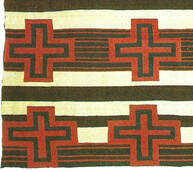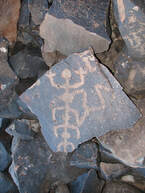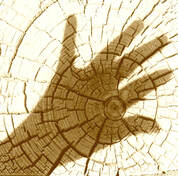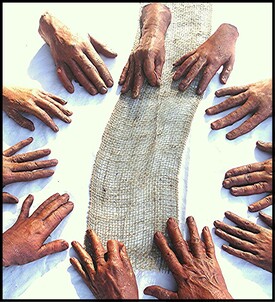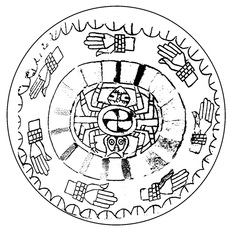 |
| "Gaia" (2005) |
“Even mainstream scientists are stumbling all over this bio-communication phenomenon. It seems impossible, given the sophistication of modern instrumentation, for us to keep missing this fundamental attunement of living things. Only for so long are we going to be able to pretend it’s the result of ‘loose wires.’ We cannot forever deny that which is so clearly there.”
It was my pleasure to encounter the work of deep ecologist and activist for the Earth Derrick Jensen recently, whose passionate and "nothing held back" books should be required reading for anyone who hopes to live into the future of our world, particularly anyone who has invested the future with the children they love. But sadly, very few people even know what
Gaia Theory is, or the name of
Derrick Jensen or
James Lovelock. In the current presidential election one of the candidates, Donald Trump, "doesn't believe in global warming". And the environment has not entered into the debates.
Yet I believe the truths Jensen, and Lovelock, speak of may very well be the most important truths of our time. Derrick Jensen kindly gave me permission to quote from him, and so I share here an excerpt from
his site, from his most recent book. I was so struck by this interview with Cleve Backster, who showed that plants, even micro-organisms, are sentient and responsive to the thoughts and intentions of life around them, The interview below demonstrates what scientists like James Lovelock, and his biologist collaborator Lynn Margulis spoke of in their
Gaia Hypothesis - that the Earth is a living being, and all aspects of life on Earth are interdependent, self-regulating, and evolving. Which includes us. As Backster comments, “The implications of all this … are staggering."
What also excited me about Mr. Jensen's excerpt was the way it revealed the mythic strands of Spider Woman, shimmering like the almost transparent, and yet infinitely strong, strands of the Great Web...........all life connected, interdependent, responsive, reciprocal..............part of the "Great Conversation".
Excerpt from :
"The Myth of Human Supremacy"
by
Derrick Jensen
www.derrickjensen.com
Almost 20 years ago I interviewed Cleve Backster about plant intelligence. No, he wasn’t a botanist. He was one of the world’s experts on the use of polygraphs, or lie detectors. I know that sounds like an odd connection, but listen to his story, and the connection will become clear. Just after World War II he was a CIA interrogation specialist, and founded The Agency’s polygraph school. In 1960 he left the CIA and formed the Backster School of Lie Detection, to instruct police officers. This school is the longest running polygraph school in existence.
Backster could name the moment the focus of his life changed forever, from lie detection to plant intelligence: early in the morning on February 2, 1966, at 13 minutes, 55 seconds of chart time for a polygraph he was administering. He had threatened the subject’s well-being in hopes of triggering a response. The subject had responded electrochemically to this threat. The subject was a plant. Here’s his story:
“I wasn’t particularly into plants, but there was a going-out-of-business sale at a florist on the ground floor of the building, and the secretary bought a couple of plants for the office: a rubber plant, and this dracaena cane. I had done a saturation watering — putting them under the faucet until water ran out the bottom of the pots — and was curious to see how long it would take the moisture to get to the top. I was especially interested in the dracaena, because the water had to climb a long trunk, and then to the end of long leaves. I thought if I put the galvanic-skin-response detector of the polygraph at the end of a leaf, a drop in resistance would be recorded on the paper as the moisture arrived between the electrodes. … I noticed something on the chart resembling a human response on a polygraph: not at all what I would have expected from water entering a leaf. Lie detectors work on the principle that when people perceive a threat to their well-being, they physiologically respond in predictable ways. If you were conducting a polygraph as part of a murder investigation, you might ask a suspect, ‘Was it you who fired the shot fatal to so and so? If the true answer were yes, the suspect will fear getting caught lying, and electrodes on his or her skin will pick up the physiological response to that fear. So I began to think of ways to threaten the well-being of the plant. First I tried dipping a neighboring leaf in a cup of warm coffee. The plant, if anything, showed what I now recognize as boredom — the line on the chart just kept trending downward.
“Then at 13 minutes, 55 seconds chart time, the imagery entered my mind of burning the leaf. I didn’t verbalize; I didn’t touch the plant; I didn’t touch the equipment. Yet the plant went wild. The pen jumped right off the top of the chart. The only new thing the plant could have reacted to was the mental image.
“I went into the next office to get matches from my secretary’s desk, and lighting one, made a few feeble passes at a neighboring leaf. I realized, though, that I was already seeing such an extreme reaction that any increase wouldn’t be noticeable. So I tried a different approach: I removed the threat by returning the matches to the secretary’s desk. The plant calmed right back down.
“Immediately I understood something important was going on. I could think of no conventional scientific explanation. There was no one else in the lab suite, and I wasn’t doing anything that might have provided a mechanistic trigger. From that split second my consciousness hasn’t been the same. My whole life has been devoted to looking into this.”
He called what the plant was doing “primary perception.” He found that not only plants were capable of this: “I’ve been amazed at the perception capability right down to the bacterial level"........“Interestingly enough, bacteria appear to have a defense mechanism such that extreme danger causes them to go into a state similar to shock. In effect, they pass out. Many plants do this as well. If you hassle them enough they flatline. The bacteria apparently did this, because as soon as they hit the cat’s digestive system, the signal went out. There was a flatline from then on.”
Cleve continued, “I was on an airplane once, and had with me a little battery-powered galvanic response meter. Just as the attendants started serving lunch, I pulled out the meter and said to the guy next to me, ‘You want to see something interesting?’ I put a piece of lettuce between the electrodes, and when people started to eat their salads we got some reactivity, which stopped as the leaves went into shock. ‘Wait until they pick up the trays,’ I said, ‘and see what happens.’ When attendants removed our meals, the lettuce got back its reactivity. I had the aisle seat, and I can still remember him strapped in next to the window, no way to escape this mad scientist attaching an electronic gadget to lettuce leaves.
“The point is that the lettuce was going into a protective state so it wouldn’t suffer. When the danger left, the reactivity came back. This ceasing of electrical energy at the cellular level ties in, I believe, to the state of shock that people, too, enter in extreme trauma. Plants, bacteria, lettuce leaves … Eggs. I had a Doberman Pinscher back in New York whom I used to feed an egg a day. One day I had a plant hooked up to a large galvanic response meter, and as I cracked the egg, the meter went crazy. That started hundreds of hours of monitoring eggs. Fertilized or unfertilized, it doesn’t matter; it’s still a living cell, and plants perceive when that continuity is broken. Eggs, too, have the same defense mechanism. If you threaten them, their tracing goes flat. If you wait about twenty minutes, they come back."
“I met a dental researcher who had perfected a method of gathering white cells from (people's) mouths. This was politically feasible, easy to do, and required no medical supervision. I started doing split-screen videotaping of experiments, with the chart readout superimposed at the bottom of the screen showing the donors activities. We took white cell samples, then sent the people home to watch a preselected television program likely to elicit an emotional response — for example, showing a veteran of Pearl Harbor a documentary on Japanese air attacks. We found that cells outside the body still react to the emotions you feel, even though you may be miles away. The greatest distance we’ve tested has been about three hundred miles. Astronaut Brian O’Leary, who wrote Exploring Inner and Outer Space, left his white cells here in San Diego, then flew home to Phoenix. On the way, he kept track of events that aggravated him, carefully logging the time of each. The correlation remained, even over that distance.”
“The implications of all this …”He interrupted, laughing. He said, “Yes, are staggering. I have file drawers full of high quality anecdotal data showing time and again how bacteria, plants, and so on are all fantastically in tune with each other. And human cells, too, have this primary perception capability, but somehow its gotten lost at the conscious level.”
“How has the scientific community received your work?”
“With the exception of scientists at the margins, like Rupert Sheldrake, it was met first with derision, then hostility, and mostly now with silence. At first they called primary perception ‘the Backster Effect,’ perhaps hoping they could trivialize the observations by naming them after this wild man who claimed to see things missed by mainstream science. The name stuck, but because primary perception can’t be readily dismissed, it is no longer a term of contempt.
“What’s the primary criticism by mainstream scientists?”
“The big problem — and this is a problem as far as consciousness research in general is concerned — is repeatability. The events I’ve observed have all been spontaneous. They have to be. If you plan them out in advance, you’ve already changed them. It all boils down to this: repeatability and spontaneity do not go together, and as long as members of the scientific community overemphasize repeatability in scientific methodology, they’re not going to get very far in consciousness research.
“Not only is spontaneity important, but so is intent. You can’t pretend. If you say you are going to burn a plant, but don’t mean it, nothing will happen. I hear constantly from people in different parts of the country, wanting to know how to cause plant reactions. I tell them, ‘Don’t do anything special. Go about your work; keep notes so later you can tell what you were doing at specific times, and then compare them to your chart recording. But don’t plan anything, or the experiment won’t work.’ People who do this often get equivalent responses to mine, and often win first prize in science fairs. But when they get to Biology 101, they’re told that what they have experienced is not important.
“There have been a few attempts by scientists to replicate my experiments … but these have all been methodologically inadequate. … It is so very easy to fail. … And let’s be honest: some of the scientists were relieved when they failed, because success would have gone against the body of scientific knowledge.”
I said, “For scientists to give up predictability means they have to give up control, which means they have to give up Western culture, which means it’s not going to happen until civilization collapses under the weight of its own ecological excesses.”
I asked if there were alternative explanations for the polygraph readings. I’d read that one person suggested his machine must have had a loose wire.
He responded, “In 31 years of research I’ve found all my loose wires. No, I can’t see any mechanistic solution. Some parapsychologists believe I’ve mastered the art of psychokinesis — that I move the pen with my mind — which would be a pretty good trick itself. But they overlook the fact that I’ve automated and randomized many of the experiments to where I’m not even aware of what’s going on until later, when I study the resulting charts and videotapes. The conventional explanations have worn pretty thin. One such explanation, proposed in Harper’s, was static electricity: if you scuffle across the room and touch the plant, you get a response. But of course I seldom touch the plant during periods of observation, and in any case the response would be totally different.”
“So, what is the signal picked up by the plant?
“I don’t know. I don’t believe the signal, whatever it is, dissipates over distance, which is what we’d get if we were dealing with electromagnetic phenomenon. I used to hook up a plant, then take a walk with a randomized timer in my pocket. When the timer went off, I’d return home. The plant always responded the moment I turned around, no matter the distance. And the signal from Phoenix was just as strong as if Brian O’Leary were in the next room. Also, we’ve attempted to screen the signal using lead-lined containers, and other materials, but we can’t screen it out. This makes me think the signal doesn’t actually go from here to there, but instead manifests itself in different places. All this, of course, lands us firmly in the territory of the metaphysical, the spiritual.”
I said, “Primary perception suggests a radical redefinition of consciousness.”
“You mean it would do away with the notion of consciousness as something on which humans have a monopoly?” He hesitated a moment, then continued, “Western science exaggerates the role of the brain in consciousness. Whole books have been written on the consciousness of the atom. Consciousness might exist on an entirely different level.”
I asked whether he had worked with materials that would normally be considered inanimate.
“I’ve shredded some things and suspended them in agar. I get electric signals, but not necessarily relating to anything going on in the environment. It’s too crude an electroding pattern for me to decipher. But I do suspect that consciousness goes much, much further. In 1987 I participated in a University of Missouri program that included a talk by Dr. Sidney Fox, then connected with the Institute for Molecular and Cellular Evolution at the University of Miami. Fox had recorded electric signals from protein-like material that showed properties strikingly similar to those of living cells. The simplicity of the material he used and the self organizing capability it displayed suggest to me that bio-communication was present at the earliest states in the evolution of life on this planet. Of course the Gaia hypothesis — the idea that the earth is a great big working organism, with a lot of corrections built in — fits in nicely with this. I don’t think it would be a stretch to take the hypothesis further and presume that the planet itself is intelligent.”
I asked how his work has been received in other parts of the world.
“The Russians and other eastern Europeans have always been very interested. And whenever I encounter Indian scientists — Buddhist or Hindu — and we talk about what I do, instead of giving me a bunch of grief they say, ‘What took you so long?’ My work dovetails very well with many of the concepts embraced by Hinduism and Buddhism.”
“What is taking us so long?”
“The fear is that, if what I am observing is accurate, many of the theories on which we’ve built our lives need complete reworking. I’ve known biologists to say, ‘If Backster is right, we’re in trouble.’ It takes a certain kind of character and personality to even attempt such a questioning of fundamental assumptions. The Western scientific community, and actually all of us, are in a difficult spot, because in order to maintain our current mode of being, we must ignore a tremendous amount of information. And more information is being gathered all the time. For instance, have you heard of Rupert Sheldrake’s work with dogs? He puts a time-recording camera on both the dog at home and the human companion at work. He has discovered that even if people come home from work at a different time each day, at the moment the person leaves work, the dog at home heads for the door.
“Even mainstream scientists are stumbling all over this bio-communication phenomenon. It seems impossible, given the sophistication of modern instrumentation, for us to keep missing this fundamental attunement of living things. Only for so long are we going to be able to pretend it’s the result of ‘loose wires.’ We cannot forever deny that which is so clearly there.”\
Excerpt first published at Utne Reader
copyright Derrick Jensen
http://www.derrickjensen.org/work/myth-of-human-supremacy/moving-goalposts-plant-intelligence/

